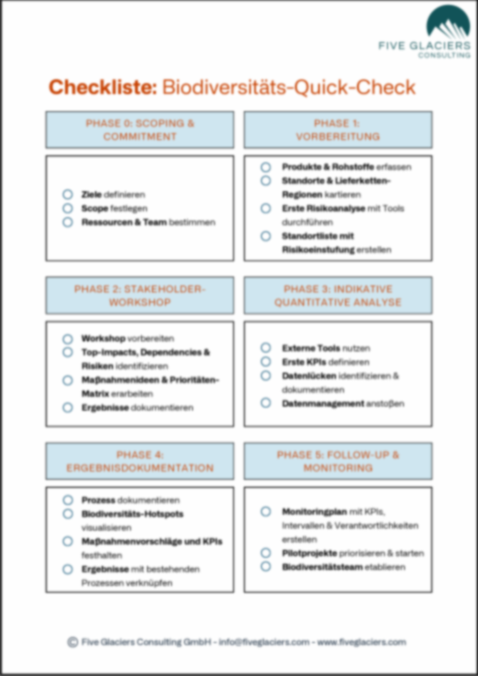
Biodiversity is an essential dimension of sustainability and an indispensable basis for economic activities. Nevertheless, its importance is often underestimated by companies. A well-founded biodiversity strategy not only helps you to meet legal requirements, but also secures you long-term competitive advantages and opens up new market opportunities.
Five Glaciers Consulting supports companies in understanding biodiversity as a strategic field of action and integrating it into their strategy in a meaningful way. We analyze the impact of your business activities on biodiversity and develop measures to protect natural habitats and safeguard ecosystem services.
For many companies, taking biodiversity into account is a new and complex challenge. Particularly in sectors where biodiversity is not directly linked to the business model at first glance, there is often a lack of awareness of its importance. The interactions between biodiversity and economic activities are often complex, and standardized methods for measurement and control are still in their infancy in many places. However, with the right approaches, companies can act proactively and gain a competitive advantage.
Five Glaciers Consulting supports you in effectively implementing biodiversity as part of your sustainability strategy. Together, we identify where your company benefits from nature - be it through raw materials, ecosystem services or other dependencies - and develop strategies to secure these in the long term. We show you how you can anchor biodiversity measures in your processes, exploit synergies with other sustainability goals and tap into market opportunities by acting with foresight.
Our workshops and training courses raise your employees' awareness of the importance of biodiversity and increase acceptance of the measures within your company.

Biodiversity is not an isolated issue, but is closely linked to other dimensions of sustainability - from climate protection and resource efficiency to social aspects. A systematic approach not only strengthens your company ecologically, but also economically. We would be happy to discuss possible synergies and further potential with you.

Develop a sustainability strategy tailored to your company - ambitious, practical and future-oriented.
learn more


Managing sustainability measurably and efficiently - with a customized management system from Five Glaciers
learn more


Your path to climate neutrality - an ambitious climate strategy that sets clear targets and has a controllable impact
learn more


Einstieg in das Biodiversitätsmanagement mit dem Biodiversitäts-Quick-Check
Nutzen Sie unsere Checkliste, um mittels unseres Biodiversitäts-Quick-Checks einen pragmatischen Einstieg in das Biodiversitätsmanagement Ihres Unternehmens zu finden.
Measuring biodiversity is much more complex than measuring greenhouse gases, for example, as there is no universal equivalent such as CO₂e. Biodiversity losses are heterogeneous, location-dependent and depend on numerous factors. A few common approaches are:
These indices provide important indications, but are not as standardized as climate data. Companies should be aware of this and use a combination of data sources and regional analyses. We help you to define the methods and KPIs for your biodiversity measurement that suit your company.
Almost every company has direct or indirect dependencies on nature. According to WEF analyses, the value chains of the following sectors are particularly affected:
We support you in identifying the direct and indirect effects of your business activities - and in developing targeted measures that both minimize risks and open up market opportunities.
The European Sustainability Reporting Standard (ESRS) E4 is a central standard for companies that are required to report under the Corporate Sustainability Reporting Directive (CSRD). ESRS E4 focuses on reporting on biodiversity and ecosystems. It is important to note that only companies that have significant dependencies or impacts on biodiversity are required to report in accordance with ESRS E4. This involves assessing whether a company's business activities:
Five Glaciers supports you in carrying out a materiality analysis to check whether your organization is affected by ESRS E4. We also help you to create and optimize your reporting so that you meet all requirements in a legally compliant and efficient manner.
Companies should identify biodiversity risks along their supply chain and implement sustainable measures. These include nature-oriented design of operating areas, sustainable procurement and the protection of ecosystems. Biodiversity measures can be combined well with climate protection strategies.
Biodiversity loss affects many sectors, for example:


Let's talk about biodiversity! We look forward to getting to know you.
Phone: +49 174 1305766
E-mail: info@fiveglaciers.com
Direct appointment booking
